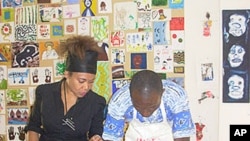In Dakar, psychiatric patients attend regular art therapy classes to help treat mental disorders ranging from addiction to schizophrenia. The therapy can be a useful technique to complement traditional forms of psychotherapy. Psychiatrists in the Senegalese capital's main hospital see it as an essential part of the healing process.
Inside the psychiatric wing at Dakar’s main hospital, Hôpital Principal de Dakar, Atta, a young Togolese, is standing in front of a blank canvas. He picks up a brush, dips it into indigo blue paint and begins sketching the contour of two doves.
Across the table from Atta is a tall, Senegalese man, very carefully painting in the helmet on the head of a commando figure. Souleyman is a soldier who has been stationed in Senegal’s conflict-ridden Casamance for the last 19 years.
Souleyman says he is here because he has had to kill people in his job, and has been suffering terrible nightmares. Every few months he comes to the hospital to see the doctor and to attend art-therapy classes. Souleyman says he feels good here because he does not need to think. He can relax and completely de-stress.
Art as psychotherapy is still relatively new in Senegal. Dr. Tabara Sylla, the hospital's chief psychiatrist, has been an advocate of art therapy since 2004, when the program began with the help of a local group known in the Wolof language as "Man Is the Helper of Man."
Dr. Sylla uses art therapy, medication and classical forms of psychotherapy in her practice, treating everything from chronic depression and autism to alcohol abuse and schizophrenia.
At first the project started as a way to keep patients busy in the afternoon, Dr. Sylla says, rather than have them sitting around smoking. It soon became clear that art was creating a communication bridge between patient and doctor. More and more now, she says, art workshops have become essential therapy - so much that she cannot imagine this psychiatric unit without them.
Traditionally, in Senegal - as in many other parts of Africa - ceremonial dances or chanting have been used as forms of therapeutic release. Felicity Kodjo, a Togolese artist, is one of five leaders of art-therapy workshops at the hospital. She believes there are important parallels between traditional forms of therapeutic expression and the art workshops.
Kodjo says the many traditional types of "soft medicine" in Africa can help relieve mental distress. In Senegal this includes forms of hypnotism and ceremonial events such as the “ndeup”, which puts participants in a type of trance. Kodjo says the traditional techniques work like art therapy, because they are emotive, pushing people to confront powerful feelings and to move beyond obstacles.
So how does art therapy work? Some therapists say the creative act itself is what aids healing, by releasing hidden emotions. Others emphasize the interpretive side of art, where images provide valuable clues to a patient’s deeper psychological issues. At the Dakar hospital, Kodjo explains:
She says art therapy is a type of mental comfort that brings relief; the interpretive elements are visible in a patient's work through repetition of images, colors and actions. A first drawing of a bird, for example, can be fairly banal. But, she says, if a patient continues to paint birds, then we can start asking key questions. This is especially useful with patients who do not speak but only communicate through images.
Dr. Sylla explains that she rarely attends the workshops herself, because it is important that patients have a neutral space to create, without doctors present.
The chief psychiatrist looks through patients’ dossiers regularly, to gauge the workshops' progress. Dr. Sylla says this can help during later personal interviews, particularly with those suffering from illnesses that inhibit verbal expression such as autism, or some forms of depression.
Dr. Sylla says the patients' artwork shows how their emotions are evolving. In interviews, she adds, the most importanrt thing is to let patients interpret their own images and tell doctors verbally what they have drawn.
Artwork by the patients in Dakar is sold at local craft fairs. There also are plans to exhibit their work at a biennial art festival beginning in May called Biennale des Arts de Dakar, known as Dak'Art 2012, scheduled May 11-June 12.
Art Therapy Helps Mentally Ill Patients in Dakar





